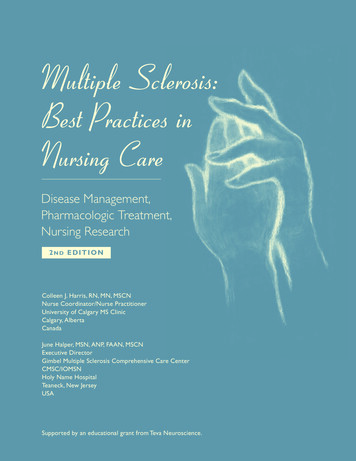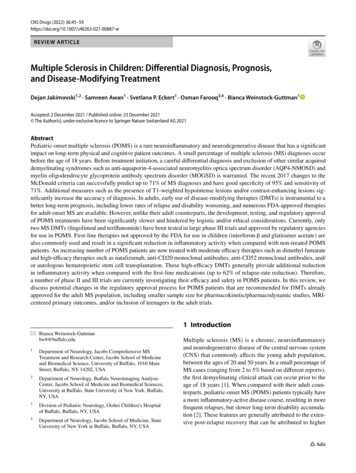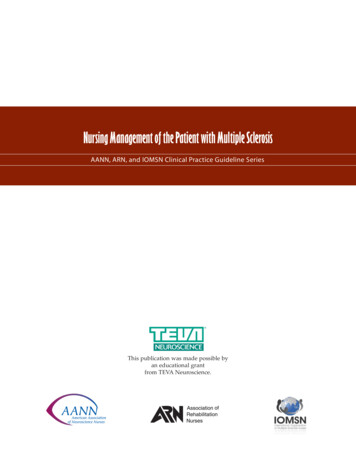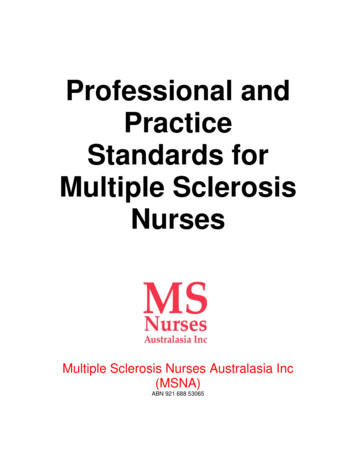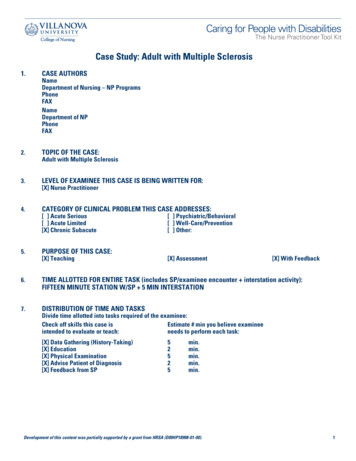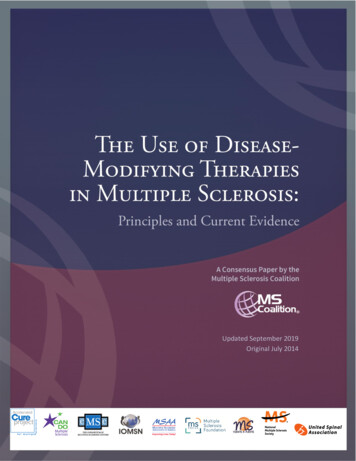
Transcription
Novel Biomarkers inMultiple SclerosisAmr HassanAssociate Professor of NeurologyCairo University
AgendaA Biomarkers for Multiple Sclerosis WHY? WHAT? WHERE? HOW? WHICH?2
A Biomarkers for Multiple Sclerosis:WHY ? One of the biggest challenges in therapeutic sonalization) of treatment in the face of anuncertain prognosis.3
A Biomarkers for Multiple Sclerosis:WHY ? A major objective at the time of the initial diagnosis isto arrest the disease at the early inflammatory stage,with the hope that this will also delay diseaseprogression and minimize future disability—a conceptthat has yet to be proven clinicallyShirani A, Zhao Y, Karim ME, Evans C, Kingwell E, van der Kop ML, et al. Association between use of interferon beta and progression of disability in patients with relapsing–remitting multiplesclerosis. JAMA. 2012;308(3):247–56.4
A Biomarkers for Multiple Sclerosis:WHY ?Treatment decisions based on the risk to benefit ratiosof each DMA are further complicated by:1.2.3.4.5.Inherent disease heterogeneity.Different MS subtypes and the rates of progression.The variety of clinical presentations (spinal cord, cerebellar,optic neuritis, cognition, fatigue, etc.).The differences in pathological subtypes, implying differentdisease mechanisms.The heterogeneity of MS is further reflected by theunpredictable efficacy of DMAs, which varies from patientto patient.Lucchinetti CF, Bruck W, Rodriguez M, Lassmann H. Distinct patterns of multiple sclerosis pathology indicates heterogeneity on pathogenesis. Brain Pathol. 1996;6(3):259–74.5
A Biomarkers for Multiple Sclerosis:WHY ? At present, the clinical parameters that are used toassess disease activity and therapeutic efficacydepend on relapses rates, MRI outcomes, andchanges in disability scores. These assessments have limited sensitivity withrespect to subclinical disease activity, especially whenrelated to gray matter changes and spinal corddisease.Sadiq S. Multiple sclerosis. In: Rowland L, editor. Merritt’s neurology. Philadelphia: Lippincott Williams and Wilkins; 2005. p. 941–63.Barkhof F. The clinico-radiological paradox in multiple scle- rosis revisited. Curr Opin Neurol. 2002;15(3):239–45.6
A Biomarkers for Multiple Sclerosis:WHY ? Thus, there is a need for sensitive, specific, andrelatively inexpensive biomarkers that can detectdisease activity and serve as surrogate markers forassessing therapeutic efficacy. Identification and validation of predictive biomarkersof therapeutic response are urgently needed to helpguide optimal treatment management strategies inpatients with MS.Harris VK, Sadiq SA. Disease biomarkers in multiple sclerosis: potential for use in therapeutic decision making. Mol Diagn Ther. 2009;13(4):225–44.7
A Biomarkers for Multiple Sclerosis:WHY ? Ultimately, accurate and sensitive biomarkers ofsubclinical disease activity will provide neurologistswith more objective tools. In addition to MRI, to better assess and predicttherapeutic outcomes in individual patients with MS.8
A Biomarkers for Multiple Sclerosis:WHY ?9
AgendaA Biomarkers for Multiple Sclerosis WHY? WHAT? WHERE? HOW? WHICH?10
A Biomarkers for Multiple Sclerosis:WHAT ?A Biomarker is a characteristic that is objectivelymeasured and evaluated as an indicator of normalbiological processes, pathogenic processes tion11
AgendaA Biomarkers for Multiple Sclerosis WHY? WHAT? WHERE? HOW? WHICH?12
1- BloodAdvantages:1.Blood collectionperformed.isaminimally2.Sampling can be carried out in large cohorts of patients, aswell as in healthy controls.3.Can easily be repeated for use in longitudinal studies.13invasiveprocedure
1- BloodDisadvantages:1.2.3.They may lack sensitivity in monitoring disease processesin the CNS, particularly with respect to monitoringprogressive disease and the effect of therapeutics aimed atneuroprotection and remyelination.Kidney function, liver function, and concomitant infectionscan influence the levels measured, as well as the time fromcollection to process.Diurinal variation14
2- CSFAdvantages:1.Ideally suited to monitoring CNS disease activity becauseof its close proximity to sites of disease pathology.1.The levels of a CSF biomarker cannot be influenced byliver or kidney functionGafson AR, Giovannoni G. Towards the incorporation of lumbar puncture into clinical trials for multiple sclerosis. Mult Scler. 2012;18(10):1509–11.15
2- CSFDisadvantages:1.The invasiveness of the collecting method narrows thepotential of multiple measurements.2.Circadian fluctuation in CSF’s production rate dictates thenecessity of standardizing the time of performing a lumbarpuncture (It is hypothesized, that CSF collection vialumbar puncture is done in morning hours, after nightfasting)16
3- UrineAdvantages: It is the easiest material to collect, even in a 24-hour basis,overcoming the obstacles offluctuations previouslymentioned.17
3- UrineDisadvantages:1.Bacterial colonization of the urinary tract though can distortthe measurements.2.MS patients with bladder dysfunction may regulate theamount of the fluids taken in a daily basis, affecting thequantity of produced urine.18
4- TearsAdvantages: There have been previous efforts in measuring OligoClonalBands (OCBs) in tears, with results comparable to those ofCSF.G. Calais, G. Forzy, C. Crinquette et al., “Tear analysis in clinically isolated syndrome as new multiple sclerosis criterion,” Multiple Sclerosis, vol. 16, no. 1, pp. 87–92, 2010.19
5- Saliva Saliva has served as a means of specifying soluble HumanLeucocyte Antigens (HLAs) type II.A. Minagar, I. Adamashvili, R. E. Kelley, E. Gonzalez-Toledo, J. McLarty, and S. J. Smith, “Saliva soluble HLA as a potential marker of response to interferon-βIa in multiple sclerosis: apreliminary study,” Journal of Neuroinflammation, vol. 4, article 16, 200720
6- MRI There are though considerable difficulties in correlating MRIfindings with disability progression. Certain novel ambitioustechniques promise to overcome all these problems.21
AgendaA Biomarkers for Multiple Sclerosis WHY? WHAT? WHERE? HOW? WHICH?22
A Biomarkers for Multiple Sclerosis:HOW ?1.Enzyme-Linked Immunosorbent Assay (ELISA)2.Immunofluorescence3.Flow Cytometry4.Polymerase Chain Reaction (PCR)5.Western Blotting6.The Nephelometry7.Isoelectric Focusing8.―-Omics‖ Technologies23
AgendaA Biomarkers for Multiple Sclerosis WHY? WHAT? WHERE? HOW? WHICH?24
A Biomarkers for Multiple Sclerosis:WHICH?GENETIC/IMMUNOGENETIC: Biomarkers specified via genomics and immunogenetictechniques.LABORATORY: All other biomarkers that can be measured in bodyfluids.IMAGING: Biomarkers provided by imaging techniques.25
A. GENETIC AND IMMUNOGENETICBIOMARKERS26
1. HLA and Therapeutical Choice HLA-DRB1*0401,0408, and 1601 alleles correlate withgreater risk of developing neutralizing antibodies againstinterferon beta (IFN-β), resulting in poor therapeuticaloutcome.D. Buck, S. Cepok, S. Hoffmann et al., “Influence of the HLA-DRB1 genotype on antibody development to interferon beta in multiple sclerosis,” Archives of Neurology, vol. 68, no. 4, pp. 480–487, 2011.27
HLA gene map
2. Non-MHC Polymorphisms AttributingGenetic Risk Various genome-wide studies revealed many non-MHCsingle nucleotide polymorphisms as candidates for geneticburden augmentation in MS. Polymorphisms of the IL2RA and IL7RA regions seem asthe most promising at the moment.International Multiple Sclerosis Genetics Consortium, “Risk alleles for multiple sclerosis identified by a genomewide study,” The New England Journal of Medicine, vol. 357, no. 9, pp. 851–862, 2007.29
3. TOB-1 TOB-1 gene has a role against T-cell multiplication, keepingautoreactive cells in a dormant state. Its degreased expression leads towards a more intenseimmune response (higher percentage of Th1 and Th17cells and lower percentage of T-regulatory cells).J. C. Corvol, D. Pelletier, R. G. Henry et al., “Abrogation of T cell quiescence characterizes patients at high risk for multiple sclerosis after the initial neurological event,” Proceedings of theNational Academy of Sciences of the United States of America, vol. 105, no. 33, pp. 11839–11844, 2008.30
4. Apolipoprotein E (ApoE) ApoE is a protein regulating lipid homeostasis, locatedmostly in astrocytes. Carrying allele of ApoE seems to attribute greater risk ofdeveloping mental disorders in MS patients.H. L. Zhang, J. Wu, and J. Zhu, “The immune-modulatory role of apolipoprotein E with emphasis on multiple sclerosis and experimental autoimmune encephalomyelitis,” Clinical andDevelopmental Immunology, vol. 2010, Article ID 186813, 10 pages, 2010.31
B. LABORATORY BIOMARKERS32
B. Laboratory BiomarkersI. Biomarkers of Immunological ActivationII. Biomarkers of NeuroprotectionIII. Biomarkers of BBB disruptionIV. Biomarkers of demyelinationV. Biomarkers of Oxidative StressVI. Biomarkers of Axonal DamageVII. Biomarkers of Glial Activation DysfunctionVIII. Biomarkers of Remyelination RepairIX. Biomarkers of Therapeutic ResponseX. Prognostic BiomarkersXI. Emering biomarkers33
IVIIIVVIIIIIIVI34
I. Biomarkers of Immunological Activation1. OCB IgG in CSF: Positive OCB IgG in the CSF of patients with CIS wasfound to duplicate the risk of progression in CDMS in a 4year observation period. Additional studies provide more evidence for OCB IgGbeing a relevant factor for conversion to CDMS.M. Tintoré, A. Rovira, J. Río et al., “Do oligoclonal bands add information to MRI in first attacks of multiple sclerosis?” Neurology, vol. 70, no. 13, pp. 1079–1083, 2008.P. Nilsson, E. M. Larsson, P. Maly-Sundgren, R. Perfekt, and M. Sandberg-Wollheim, “Predicting the outcome of optic neuritis: evaluation of risk factors after 30 years of follow-up,” Journalof Neurology, vol. 252, no. 4, pp. 396–402, 2005.35
I. Biomarkers of Immunological Activation2. OCB IgM in CSF Some researchers consider them as a bad prognosticbiomarker, correlating with disability progression bothqualitatively and quantitatively (IgM index). OCB IgM against certain myelin lipids may declare a moreaggressive disease course.J. Mandrioli, P. Sola, R. Bedin, M. Gambini, and E. Merelli, “A multifactorial prognostic index in multiple sclerosis: cerebrospinal fluid IgM oligoclonal bands and clinical features to predict theevolution of the disease,” Journal of Neurology, vol. 255, no. 7, pp. 1023–1031, 2008.L. Villar, N. Garcia-Barragan, M. Espino, et al., “Influence of oligoclonal IgM specificity in multiple sclerosis disease course,” Multiple Sclerosis, vol. 14, pp. 183–187, 2008.36
I. Biomarkers of Immunological Activation3. Kappa Free (KFLC) and Lambda Free Light Chains(LFLC) in CSF KFLC high CSF levels have been repeatedly reported inMS. In comparison to OCB IgG, slightly higher sensitivitywith slightly lower specificity has been found.KFLC high CSF levels are considered as highly predictivefor CIS conversion to CDMS.LFLC also represent a sensitive indicator of intrathecalsynthesis in inflammatory CNS disorders.S. Presslauer, D. Milosavljevic, T. Brücke, P. Bayer, and W. Hübl, “Elevated levels ofkappa free light chains in CSF support the diagnosis of multiple sclerosis,” Journal ofNeurology, vol. 255, no. 10, pp. 1508–1514, 2008.L. M. Villar, M. Espino, L. Costa-Frossard, A. Muriel, J. Jimenez, and J. C. AlvarezCermeno, “High levels of cerebrospinal fluid free kappa chains predict conversion tomultiple sclerosis,” Clinica Chimica Acta, vol. 413, no. 23-24, pp. 1813–1816, 2012.B. Arneth and F. Birklein, “High sensitivity of free lambda and free kappa light chainsfor detection of intrathecal immunoglobulin synthesis in cerebrospinal fluid,” ActaNeurologica Scandinavica, vol. 119, no. 1, pp. 39–44, 2009.37
I. Biomarkers of Immunological Activation4. Measles-Rubella-Zoster Endothecal Reaction (MRZReaction) MRZ IgG reaction in CSF displays, compared to OCB IgG,a higher specificity for MS diagnosis and higher prognosticvalue of progression from CIS to CDMS [48]. Moreover, MRZ reaction indicates a primarily B-cellmediated immune response, guiding therapeutical choicetowards a relevant immunomodulating agent [49].J. Brettschneider, H. Tumani, U. Kiechle et al., “IgG antibodies against measles, rubella, and varicella zoster virus predict conversion to multiple sclerosis in clinically isolated syndrome,” PLoSOne, vol. 4, no. 11, article e7638, 2009.E. Meinl, M. Krumbholz, and R. Hohlfeld, “B lineage cells in the inflammatory central nervous system environment: migration, maintenance, local antibody production, and therapeuticmodulation,” Annals of Neurology, vol. 59, no. 6, pp. 880–892, 2006.38
I. Biomarkers of Immunological Activation5. Epstein-Barr Virus (EBV) Reaction Cepoket al. reported a high percentage of IgG antibodiesagainst protein epitopes BRRF2 and EBNA-1 of the virus,in the serum and CSF samples from MS patients. EBV antibodies are considered as indicative of higherinflammatory activity and early disease onset.S. Cepok, D. Zhou, R. Srivastava et al., “Identification of Epstein-Barr virus proteins as putative targets of the immune response in multiple sclerosis,” Journal of Clinical Investigation, vol.115, no. 5, pp. 1352–1360, 2005.D. Buljevac, G. Van Doornum, H. Flach, et al., “Epstein-Barr virus and disease activity in multiple sclerosis,” Journal of Neurology, Neurosurgery & Psychiatry, vol. 76, pp. 1377–1381, 2005.39
I. Biomarkers of Immunological Activation6. Chemokines Chemokine CXCL13 mobilizes B-cells and T-helper cellstowards active demyelinating lesions by interacting withCXCR5 receptor.Consistent correlation of CXCL13 CSF levels with CSF Bcells, plasmablasts, and intrathecal Ig synthesis has beenreported.High levels of CXCL13 have been found in patients withCIS and CDMS.M. C. Kowarik, S. Cepok, J. Sellner, et al., “CXCL13 is the major determinant for B cell recruitment to the CSF during neuroinflammation,” Journal of Neuroinflammation, vol. 9, article 93,2012.F. Sellebjerg, L. Börnsen, M. Khademi et al., “Increased cerebrospinal fluid concentrations of the chemokine CXCL13 in active MS,” Neurology, vol. 73, no. 23, pp. 2003–2010, 2009.40
I. Biomarkers of Immunological Activation7. Cytokines IFN-γ and TNF-a are the main products of Th1 immuneresponse.IL-6 serves as linking arm between B-cell and T-cellimmune response as well as a Th-17 response triggeringfactor.IL-6 serum levels were found to correlate significantly withthe relapse frequency in female MS patients and age atonset for all MS patients.Y. C. Chen, X. Yang, L. Miao, et al., “Serum level of interleukin-6 in Chinese patients with multiple sclerosis,” Journal of Neuroinflammation, vol. 249, no. 1-2, pp. 109–111, 2012.41
I. Biomarkers of Immunological Activation7. Cytokines Moreover,studying IL-1 levels in mice led to theconclusion that any imbalance in the IL-1 signalling(increased or decreased) may lead to CNS demyelination. IL-10 is considered as the mainanti-inflammatorycytokine. Recent research implicates single nucleotidepolymorphisms at the 592 position of the IL-10 gene tothe regulation of CNS autoimmunity.B. S. Kim, Y. H. Jin, L. Meng, et al., “IL-1 signal affects both protection and pathogenesis of virus-induced chronic CNS demyelinating disease,” Journal of Neuroinflammation, vol. 9, no. 1,article 217, 2012.M. N. Karimabad, M. K. Arababadi, E. Hakimizadeh, et al., “Is the IL-10 promoter polymorphism at position -592 associated with immune system-related diseases?” Inflammation. In press.42
I. Biomarkers of Immunological Activation7. Cytokines Flow cytometric analysisrevealed that B-cells andmonocytes from MS patients overexpress IL-15, and thatstimulation of CD8( ) T-cells with the latter cytokineenhances their ability to kill glial cells and enter the BBB. IL-15 was found elevated in the sera and CSF of MSpatients, in comparison with ONDs.R. Schneider, A. N. Mohebiany, I. Ifergan, et al., “B cell-derived IL-15 enhances CD8 T cell cytotoxicity and is increased in multiple sclerosis patients,” The Journal of Immunology, vol. 187, no.8, pp. 4119–4128, 2011.M. Rentzos, C. Cambouri, A. Rombos et al., “IL-15 is elevated in serum and cerebrospinal fluid of patients with multiple sclerosis,” Journal of the Neurological Sciences, vol. 241, no. 1-2, pp.25–29, 2006.43
I. Biomarkers of Immunological Activation8. Adhesion Molecules Proinflammatory cytokines cause a rise in CSF expressionof sICAMs. High levels of ICAM-1 molecule correlatepositively with higher disease activity. Higher CSF levels of sICAM-1 and sVCAM-1 werereported in NMO patients,in comparison with MSpatients, suggesting that the BBB in NMO displays moresevere alterations.G. Acar, F. Idiman, G. Kirkali et al., “Intrathecal sICAM-1 production in multiplesclerosis correlation with triple dose Gd-DTPA MRI enhancement and IgG index,”Journal of Neurology, vol. 252, no. 2, pp. 146–150, 2005.45A. Uzawa, M. Mori, S. Masuda, and S. Kuwabara, “Markedly elevated solubleintercellular adhesion molecule 1, soluble vascular cell adhesion molecule 1 levels,and blood-brain barrier breakdown in neuromyelitis optica,” Archives ofNeurology, vol. 68, no. 7, pp. 913–917, 2011.
I. Biomarkers of Immunological Activation8. Adhesion Molecules Finally, laminin 411, which is situated within the vascularendothelium, interacts with adhesion molecule CD146,allowing Th17 cells to overcome the BBB.K. Flanagan, K. Fitzgerald, J. Baker, et al., “Laminin-411 is a vascular ligand for MCAM and facilitates TH17 cell entry into the CNS,” PLoS One, vol. 7, no. 7, article e40443, 2012.46
I. Biomarkers of Immunological Activation9. Osteopontin Osteopontin is a macrophage derived phosphoproteinwhich enhances IFN-γ and IL-12 levels and diminishes thelevels of neuroprotective IL-10. Serum and CSF osteopontin levels are upregulated duringan MS relapse, but this is also the case for many otherinflammatory disorders.M. Braitch, R. Nunan, G. Niepel, L. J. Edwards, and C. S. Constantinescu, “Increased osteopontin levels in the cerebrospinal fluid of patients with multiple sclerosis,” Archives of Neurology, vol. 65,no. 5, pp. 633–635, 2008.47
48
I. Biomarkers of Immunological Activation10. Fetuin-A Fetuin-A (alpha2 Hermans Schmid glycoprotein) is acalcium-regulating surface glycoprotein. Protein’s codingm-RNA is overexpressed in MS patients’ CNS, resulting inits high concentrations in active demyelinating lesions. Fetuin-A seems to antagonize anti-inflammatory TGF-β1.Good responders in Natalizumab treatment present areduction in Fetuin-A CSF levels.Q. Yan, R. Donelan, J. Dinzey, M. Rammal, and S. Sadiq, “Fetuin-A is a biomarker for disease activity and treatment efficacy in multiple sclerosis,” in Proceedings of the European Committee forTreatment and Research in Multiple Sclerosis (ECTRIMS '08), p. 897, Montreal, Canada, 2008.49
II. Biomarkers of Neuroprotection1. Vascular Endothelial Growth Factor-A (VEGF-A) VEGF-A is a factor of angiogenesis with neuroprotectiveproperties. Diminished m-RNA expression of VEGF-A inserum monocytes of patients with SPMS compared toRRMS patients has been reported. VEGF-A could serve asRRMS to SPMS.biomarker of progression fromE. Iacobaeus, P. Amoudruz, M. Ström et al., “The expression of VEGF-A is down regulated in peripheral blood mononuclear cells of patients with secondary progressive multiple sclerosis,” PLoSOne, vol. 6, no. 5, article e19138, 2011.50
II. Biomarkers of Neuroprotection2. Vitamin D Vitamin D suppresses Th1 immune response and enablestheproduction of many neurotrophic factors. 25Hydroxyvitamin D levels inuntreated MS patientscorrelate inversely with radiologic disease activity. Recently, a vitamin D response element (VDRE) wasrecognized close to the HLA-DRB1*1501 coding area, withthe aid of genomics.K. I. Løken-Amsrud, T. Holmøy, S. J. Bakke, et al., “Vitamin D and disease activity in multiple sclerosis before and during interferon-β treatment,” Neurology, vol. 79, no. 3, pp. 267–273, 2012.51
II. Biomarkers of Neuroprotection2. Vitamin D Vitamin D displays an inhibitory role in MS, also at agenetic level, by interacting with VDRE. Interestingly, Stewart et al. recently concluded that part ofIFN-β therapeutic effects during MS relapses may beattributed to greater production of Vitamin D.S. V. Ramagopalan, N. J. Maugeri, L. Handunnetthi et al., “Expression of the multiple sclerosis-associated MHC class II allele HLA-DRB1*1501 is regulated by vitamin D,” PLoS Genetics, vol. 5, no.2, article e1000369, 2009.N. Stewart, S. Simpson Jr., I. van der Mei, et al., “Interferon-β and serum 25-hydroxyvitamin D interact to modulate relapse risk in MS,” Neurology, vol. 79, no. 3, pp. 254–260, 2012.52
III. Biomarkers of BBB disruption1. Matrix Mettalloproteinase Proteins (MMPs) Serum and CSF MMPs levels are constantly elevatedduring MS relapse. MMP-9 levels have been foundelevated in patients with RRMS. CSFCCR2( )CCR5( )CCR6( )T-cellpopulationexpresses high levels of MMP-9 during relapse.C. Avolio, M. Ruggieri, F. Giuliani et al., “Serum MMP-2 and MMP-9 are elevated in different multiple sclerosis subtypes,” Journal of Neuroimmunology, vol. 136, no. 1-2, pp. 46–53, 2003.W. Sato, A. Tomita, D. Ichikawa, et al., “CCR2 CCR5 T cells produce matrix metalloproteinase-9 and osteopontin in the pathogenesis of multiple sclerosis,” The Journal of Immunology, vol. 189,no. 10, pp. 5057–5065, 2012.54
III. Biomarkers of BBB disruption2. Ninjurin-1 The degree of expression of the protein Ninjurin-1 byendothelial cells ofthe BBB and myeloid antigenpresenting cells (APCs) plays an important role in thetransmigration and localization of the latter inside CNS, asit was made obvious by proteomic screen of human BBBcells. Ninjurin-1 was found up-regulated in active demyelinatinglesions.I. Ifergan, H. Kebir, S. Terouz, et al., “Role of Ninjurin-1 in the migration of myeloid cells to central nervous system inflammatory lesions,” Annals of Neurology, vol. 70, no. 5, pp. 751–763, 2011.55
III. Biomarkers of BBB disruption3. sICAM-1 CSF sICAM-1 levels from NMO patients were found tocorrelate adequately with other measures of BBBdisruption, like the albumin quotient and the gadoliniumenhanced lesions in MRI.A. Uzawa, M. Mori, S. Masuda, and S. Kuwabara, “Markedly elevated soluble intercellular adhesion molecule 1, soluble vascular cell adhesion molecule 1 levels, and blood-brain barrierbreakdown in neuromyelitis optica,” Archives of Neurology, vol. 68, no. 7, pp. 913–917, 2011.56
III. Biomarkers of BBB disruption4. Endothelin System The term refers to an endothelial proteinic system thatplays role in the transmigration of monocytes through theBBB. Major components of thissystem are the proteinsendothelin-1, endothelin type B receptor, and endothelinconverting enzyme-1.A. Reijerkerk, K. A. Lakeman, J. A. Drexhage, et al., “Brain endothelial barrier passage by monocytes is controlled by the endothelin system,” Journal of Neurochemistry, vol. 121, no. 5, pp. 730–737, 2012.57
IV. Biomarkers of demyelination1. Myelin Basic Protein (MBP) And its fragments are found in large quantities in the CSFof most MS patients during a relapse (80%).F. Sellebjerg, M. Christiansen, and P. Garred, “MBP, anti-MBP and anti-PLP antibodies, and intrathecal complement activation in multiple sclerosis,” Multiple Sclerosis, vol. 4, no. 3, pp. 127–131,1998.58
IV. Biomarkers of demyelination2. αB-Crystalline αB-Crystalline is aheat-shock protein which formsaggregates during stress. Its mechanism of action encompasses activation of IL-17,IL-10, IL-13, TNF, and chemokines CCL5 and CCL1.J. M. van Noort, M. Bsibsi, W. H. Gerritsen et al., “αB-crystallin is a target for adaptive immune responses and a trigger of innate responses in preactive multiple sclerosis lesions,” Journal ofNeuropathology and Experimental Neurology, vol. 69, no. 7, pp. 694–703, 2010.59
V. Biomarkers of Oxidative Stress on can increase the level of metabolic andoxidative stress, which in turn likely contribute to diseaseprogression. Biomarkers indicative of oxidative stress pathway activitywould help quantify the impact of oxidative stress ondisease progression in MS.Lassmann H, van Horssen J, Mahad D. Progressive multiple sclerosis: pathology and pathogenesis. Nat Rev Neurol. 2012;8(11):647–56.60
V. Biomarkers of Oxidative Stress1. Nitric Oxide (NO) High serum and CSF levels of NO in inflammatoryneurological disorders were reported. Higher CSF concentrations were further correlated withhigher disability progression rates in MS.K. Rejdak, M. J. Eikelenboom, A. Petzold et al., “CSF nitric oxide metabolites are associated with activity and progression of multiple sclerosis,” Neurology, vol. 63, no. 8, pp. 1439–1445, 2004.61
V. Biomarkers of Oxidative Stress2. Reactive Oxygen Species (ROS) ROS damage oligodendrocytes and myelin through radicalmediated oxidation. Myelin cholesterol breaks down to 7-ketocholesterol,whose levels in the CSF of MS patients have beenreported to be elevated.A. Diestel, O. Aktas, D. Hackel et al., “Activation of microglial poly(ADP-ribose)-polymerase-1 by cholesterol breakdown products during neuroinflammation: a link between demyelination andneuronal damage,” Journal of Experimental Medicine, vol. 198, no. 11, pp. 1729–1740, 2003.62
V. Biomarkers of Oxidative Stress3. The isoprostane 8-iso-prostaglandin F2a (8-isoPGF2a) Increased levels of 8-iso-PGF2a have been detected inurine and plasma from patients with MS. Highly elevated CSF 8-iso-PGF2a levels were observed in31 % of patients with SPMS, identifying a subset ofpatients with progressive MS that exhibited quantifiableevidence of oxidative stress.Miller E, Mrowicka M, Saluk-Juszczak J, Ireneusz M. The level of isoprostanes as anon-invasive marker for in vivo lipid per- oxidation in secondary progressivemultiple sclerosis. Neuro- chem Res. 2011;36(6):1012–6.63Teunissen CE, Sombekke M, van Winsen L, Killestein J, Barkhof F, Polman CH, et al.Increased plasma 8,12-iso-iPF2alpha-VI levels in relapsing multiple sclerosis patients arenot predictive of disease progression. Mult Scler. 2012;18(8):1092–8.Mir F, Lee D, Ray H, Sadiq SA. Cerebrospinal fluid isoprostane levels are a biomarker ofoxidative stress in multiple sclerosis. Neurol Neuroimmunol Neuroinflammation. 2014 (inpress).
V. Biomarkers of Oxidative Stress4. Lactate Mitochondrial dysfunction is an important feature in MSand of particular relevance to the neurodegenerativephase of the disease.Measurement of serum lactate in MS might be a relativeinexpensive test for longitudinal monitoring of "virtualhypoxia" in MS and also a secondary outcome fortreatment trials aimed to improve mitochondrial functionin patients with MS.Amorini AM, Nociti V, Petzold A, Gasperini C, Quartuccio E, Lazzarino G. et al. Serum lactate as a novel potential biomarker in multiple sclerosis. Biochimica et Biophysica Acta (BBA)-MolecularBasis of Disease. 2014 1842(7):1137-1143.64
VI. Biomarkers of Axonal Damage1. Neurofilaments (NFs) Neurofilaments are major axonal cytoskeleton proteinsconsisting of three subunits (light chain/NF-L, intermediatechain/NF-M, and heavy chain/NF-H). NF-L CSF levels inMS patients are considerably higher compared to healthycontrols. On the other hand, NF-H chains seem to correlate betterwith disease progression, with significant elevationrecorded only in progressive disease forms.M. Gunnarsson, C. Malmeström, M. Axelsson et al., “Axonal damage in relapsing multiple sclerosis is markedly reduced by natalizumab,” Annals of Neurology, vol. 69, no. 1, pp. 83–89, 2011.A. Petzold, M. J. Eikelenboom, G. Keir et al., “Axonal damage accumulates in the progressive phase of multiple sclerosis: three year follow up study,” Journal of Neurology, Neurosurgery andPsychiatry, vol. 76, no. 2, pp. 206–211, 2005.65
VI. Biomarkers of Axonal Damage2. Tau Protein Tau is a cytoskeleton protein whose basic responsibility ismicrotubular stabilization. High CSF levels in MS patientshave been reported. Simultaneous elevation in Tau and NF-H values in CSF, inpatients with CIS, has a 70% predictive value ofconversion to CDMS, which is superior to the predictivevalue of MRI.J. Brettschneider, A. Petzold, A. Junker, and H. Tumani, “Axonal damage markers in the cerebrospinal fluid of patients with clinically isolated syndrome improve predicting conversion to definitemultiple sclerosis,” Multiple Sclerosis, vol. 12, no. 2, pp. 143–148, 2006.66
VI. Biomarkers of Axonal Damage3. Microtubules Microtubules represent a major structural cytoskeletoncomponent, consisting of two subunits, A- and B-tubulin. Elevated CSF tubulin and actin values have been reportedin progressive disease forms, correlating well with disabilitymeasured by EDSS.Kanter JL, Narayana S, Ho PP, Catz I, Warren KG, Sobel RA, et al. Lipid microarrays identify key mediators of autoimmune brain inflammation. Nat Med. 2006;12(1):138–43.68
VI. Biomarkers of Axonal Damage4. Amyloid-β (1–42) In Alzheimer’s disease, amyloid-β (1–42) accumulates inextracellular insoluble plaques, resulting in reduced CSFlevels.CSF reduction can be also observed in MS patients, incorrelation with greater risk for cognitive decline.Wang D, Bhat R, Sobel RA, Huang W, Wang LX, Olsson T, et al. Uncovering Cryptic Glycan Markers in Multiple Sclerosis (MS) and Experimental Autoimmune Encephalomyelitis (EAE). Drug DevRes. 2014;75(3):172–88.69
VI. Biomarkers of Axonal Damage5. 14-3-3 Protein Apart from Creutzfeldt-Jacobs disease, elevated CSFvalues have been reported in 10%–30% of patients withRRMS, but its potential utility as a biomarker for MS seemslimited for the time being.Kanter JL, Narayana S, Ho PP, Catz I, Warren KG, Sobel RA, et al. Lipid microarrays identify key mediators of autoimmune
Sadiq S. Multiple sclerosis. In: Rowland L, editor. Merritt’s neurology. Philadelphia: Lippincott Williams and Wilkins; 2005. p. 941–63. Barkhof F. The clinico-radiological paradox in multiple scle- rosis revisited. Curr Opin Neurol. 200
